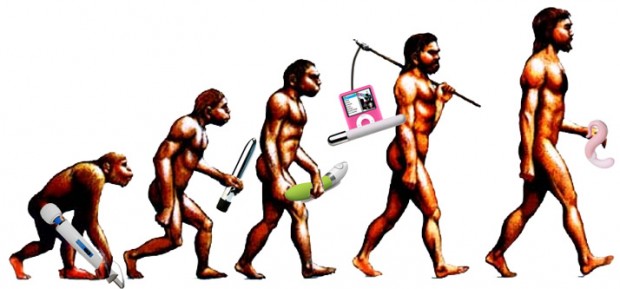“Vibration is Life,” read a print commercial from 1910 advertising a vibrator. This hot new technology became available at the turn of the century when household electricity swept through America. Vibrators were originally developed to replace the tedious task of manual stimulation used by the doctors who were treating women with what they called “hysteria.” The original booty calls, these doctors, were put out of business with the advent of the consumer friendly vibrator in 1900. And one hundred years later, the technology just keeps getting better.
The first vibrator made for medical purposes was released to doctors in 1880, with a consumer friendly version available in 1900, making the electric vibrator the 5th consumer friendly electric product available. The idea was to plug the bulky thing into the wall and let it pulsate for external or and sometimes internal stimulation. A metal device with a little rubber tip, these vibrators didn’t resemble the real thing but rather a dentist’s drill or hand held egg beater. Besides the electric vibrator, there were both hand crank and battery versions available as well. The most interesting was the air powered vibrator that plugged into a lady’s vacuum cleaner. Imagine walking in on that one.
Vibrators became taboo sometime around the 1920s when porn was considered not suitable for polite conversation (it’s not?). Between the 1920s and 1980s, vibrators were marketed as “personal massagers” or “blood circulators,” with their true purpose concealed. Vibrators really began to evolve in the 1970s with the invention of the Hitachi Magic Wand. Much like the original vibrators, this vibrating device was originally marketed for medical purposes as a personal body massager. Probably now one of the most infamous sex toys, this bad boy is a couple’s favorite and was discreet enough to pass as a massager from the Sharper Image back in the day.
In the 1980s when Americans began to become more sexualized, vibrators went from being ambiguous looking items to more realistic looking vibrating dildos. When mainstream stores like the Condom Store in NYC and TV shows like Sex and the City started promoting vibrator use in the 1980s and 1990s, vibrators began to again popularize in the mainstream. Since the 1980s and 1990s when the flood gates really opened, every type of vibrator under the sun has surfaced. Jelly dildos, the Pocket Rocket, discreet vibrating lipsticks, and the now iconic Rabbit Vibrator have become commonplace in the U.S. The Rabbit, a vibrating, undulating, dildo, filled with pearls to stimulate the G-spot and clit, took vibrator technology to the next level by combining clitoral stimulation, internal penetration, and G-spot action in one – setting the bar high for future vibrators.
Since the invention of the Rabbit, vibrator technology has taken off. Vibrators made by companies like the Swedish design firm Lelo, are investments focused on design, functionality, ease of use, and material. Companies like OhMiBod take regular looking vibrators to the next level by offering vibes that sync with your iPod and pulsate to the beat. Remote controlled body worn vibrators have also become commonplace, great for couples looking for that extra oomph in the bedroom or while out to dinner. And vibrators aren’t just for women anymore, instead, male versions are surfacing such as the Fleshlight Vibro. The main trend in vibrator technology is to create a device that more closely mimics a real sexual experience, to go beyond a standard phallic shaped vibrator focused on clit or internal stimulation. Companies try to titillate and excite by mimicking the surprise and variation of real life sex. For example, the Sqweel was a completely new design in vibrators that mimicked oral sex with ten spinning tongues. Even cooler, is the Sasi vibrator that moves like an actual tongue with different variations and speeds. If you dislike a certain motion, you can press a button to skip it and the Sasi will be less likely to use that move in your next session. This smart learning toy remembers what you like and dislike to provide you with a super satisfying and varied oral sex like stimulation from a toy who’s jaw doesn’t get tired. We can only imagine what the future of vibrators might be: possibly a Facebook and Twitter connect? Hey, it could happen.
Guest columnist Lydia Leavitt writes about sex and, oddly enough, social media. For more information on the latest intimate technology, check out 69adget.com.


